Marketers face a critical challenge: 73% of customers interact with multiple touchpoints before purchase, yet many platforms restrict access to valuable data from these interactions. Siloed customer data prevents brands from answering fundamental questions about customer acquisition and persona development.
This guide provides actionable strategies for implementing cross-channel marketing analytics in complex environments. It covers data integration methods, attribution modeling strategies, and techniques for extracting actionable insights from multi-channel data.
With the right approach, you will be able to connect the dots across platforms and optimize every marketing dollar.
What is cross-channel marketing analytics?
Cross-channel analytics answers critical questions:
- Which channel combinations drive the highest conversion rates,
- How different segments interact across channels,
- Where friction points exist in cross-channel journeys,
- Which touchpoint sequences optimize acquisition costs.
It delivers a clear picture of what drives results. Instead of relying on isolated metrics, it connects interactions across platforms to reveal patterns in customer behavior and valuable insights on channel intersection.
The advantages of cross-channel marketing campaigns
Understanding the benefits of cross-channel marketing is essential for marketers who need to justify technology investments, secure budget approval, and demonstrate strategic value to leadership.
#1. Cross-channel marketing attracts more clients
Cross-channel marketing increases customer acquisition by creating strategic touchpoint frequency across multiple platforms. This approach leverages the psychological principle of effective frequency—research shows consumers need at least 7 brand exposures before taking action.
The core mechanism is creating reinforced messaging that builds both recognition and consideration through coordinated exposures.
Let’s look an example from the automotive industry, each touchpoint serves a specific function in the decision journey:
- Radio establishes awareness and plants the initial consideration seed
- Social proof via targeted ads and peer content builds legitimacy
- Entertainment integrations normalize ownership and create aspirational triggers
Cross-channel analytics quantifies this journey by tracking attribution sequences that reveal which touchpoint combinations drive dealership visits. This data shows which channels serve as initial awareness drivers versus final conversion catalysts.
#2. Cross-channel marketing is scalable
Cross-channel marketing creates system resilience through diversified traffic sources, preventing dependency on any single channel's vulnerabilities.
- Paid media: Digital marketing advertising delivers immediate, controllable traffic volume but operates as a tap—when spending stops, traffic ceases. This model creates cash flow vulnerability and increasing competition drives up acquisition costs over time.
- Social media: Social platforms provide rapid brand visibility and targeted engagement but suffer from content saturation and algorithm volatility.
- Content marketing: SEO-optimized content generates sustainable long-term traffic that continues performing independently of ongoing investment. This method avoids ad blockers (used by over 40% of Americans) but needs time for rankings to improve.
- Email marketing: Email delivers consistently high ROI (average $42 per $1 spent) with direct audience ownership. Unlike third-party platforms, companies maintain full control over their subscriber relationships, though effectiveness depends on list quality and deliverability rates.
- Influencer marketing: This channel leverages established trust relationships between creators and audiences. While providing access to pre-qualified audiences, it requires careful alignment between brand values and influencer authenticity to be effective.
Using a cross-channel strategy helps protect against the weaknesses of individual channels, like sudden changes in algorithms, rising costs, or oversaturation in the market. It allows for testing new channels while keeping overall performance stable. Having a variety of channels also lays a solid groundwork for safely scaling up strategies without relying too heavily on any single channel.
#3. Cross-channel marketing improves the customer experience
Cross-channel marketing improves the customer experience by making their journey through different media feel more connected and relevant.
For example, if a customer looks up a product on their phone, then gets an email about it, and later sees ads for similar items, the whole process feels unified.
This method solves the issue of "fragmented journeys" where using just one channel might leave gaps in the experience. By using cross-channel analytics, companies can spot these gaps and see how they affect sales and customer happiness.
#4. Cross-channel marketing adds new touchpoints to the buyer journey
Around half of all companies use only 3-4 channels in their marketing campaigns.
Expanding the number of touchpoints can significantly increase customer engagement. Customers who interact through 10 or more channels tend to make purchases weekly, which greatly boosts their lifetime value.
Yet, this strategy is underused, with only 4% of brands engaging on 10+ channels.
Multichannel vs. omnichannel vs. cross-channel marketing
These three concepts might sound the same, but in practice, they have distinct differences.
Each approach requires different measurement frameworks and data architectures. Without clarity, organizations typically:
- Invest in the wrong analytics tools and infrastructure that don't capture the data relationships they actually need.
- Misinterpret analytics results by applying multichannel metrics to cross-channel strategies.
- Set incorrect metrics and KPIs that don't align with their actual marketing approach.
- Make flawed marketing budget allocations based on incomplete attribution understanding.
Multichannel marketing
This creates data silos where metrics like email open rates, social media engagement, and website conversions are analyzed separately. While this provides channel-specific insights, it fails to capture how channels influence each other.
Cross-channel marketing
This approach reveals which channel combinations drive conversions, how channels complement each other, and the optimal sequencing of touchpoints for different segments.
Omnichannel marketing
This approach emphasizes brand perception metrics and experience continuity rather than channel-specific attribution.
| Feature | Multichannel Marketing | Cross-Channel Marketing | Omnichannel Marketing |
|---|---|---|---|
| Definition | Uses multiple independent marketing channels (e.g., social media, email, paid ads) without integration. | Connects multiple channels, allowing them to share data for a more cohesive customer experience. | Fully integrates all channels, ensuring a seamless and unified experience across all touchpoints. |
| Data sharing | Minimal or no data sharing between channels; each operates in silos. | Moderate data sharing between some channels, often through tracking pixels or attribution models. | Full data synchronization across all channels. |
| Customer experience | Inconsistent; customers may receive conflicting messages across different channels. | More streamlined than multichannel, but gaps in personalization may still exist. | Seamless and highly personalized, with contextual interactions based on real-time data. |
| Marketing attribution | Channel-specific tracking, often last-click attribution. | Uses multi-touch attribution models to assess cross-channel influence. | Full customer journey tracking, including online and offline interactions. |
| Consistency in messaging | Inconsistent; each channel runs its own campaigns without unified messaging. | More consistent messaging across integrated channels but not fully synchronized. | Fully synchronized messaging across all channels in real time. |
| Best use cases | Businesses with limited marketing resources or separate channel strategies (e.g., small brands focusing on independent campaigns). | Brands optimizing for performance marketing and attribution but without full omnichannel capabilities (e.g., ecommerce brands using coordinated paid ads and email marketing). | Large enterprises prioritizing customer lifetime value and retention (e.g., retailers offering fully integrated online and in-store experiences). |
Common challenges in cross-channel analytics
Like any other complex concept, cross-channel marketing has several pitfalls that you should be aware of.
1. Data integration issues
Cross-channel data is often siloed, with each platform using different metrics, naming conventions, and reporting formats. Bringing together data from social media, email, websites, mobile apps, and offline interactions can be complex and requires the right tools and strategy.
2. Tracking gaps
Tracking users across devices and platforms is harder than ever due to cookie deprecation, privacy laws like GDPR and HIPAA, and limits on third-party tracking.
This fragmentation and lack of a universal identifier makes it difficult to understand how different marketing efforts contribute to conversions and long-term customer value.
3. Balancing effort across multiple channels
One of the biggest challenges in cross-channel marketing is allocating resources effectively across different platforms. Marketers often double down on their top-performing channels, but relying too heavily on a few can limit long-term growth and customer engagement.
A true cross-channel strategy requires consistent investment in multiple touchpoints—social media, email, paid ads, content marketing, and more. Each channel plays a role in shaping customer perception, nurturing leads, and driving conversions. However, spreading resources too thin can lead to inefficiencies, while overinvesting in one or two platforms may create blind spots in the customer journey.
How to get started with cross-channel marketing
We discussed how cross-channel marketing and analytics work in theory. But how do you implement it in the real world?
This section explains all of the steps you need to take to drive more leads and improve your customers’ experience.
1. Building your foundation
- Start by analyzing your existing customer data to identify patterns and characteristics. Analyze where high-value customers engage, how different channels complement each other, and where incremental gains can be achieved.
- These insights help you select the right channels and craft messaging that resonates across platforms.
- Create a single source of truth. It can be an ETL solution or customer data platform (CDP) that ensures all customer interactions from various channels are captured and structured for accurate analysis.
2. Execution strategy
- Map the customer journey. Track interactions across your brand ecosystem and capture things like emotional triggers driving behavior at each stage, decision factors that prompt channel transitions, potential friction points where messaging consistency might break, and opportunities for personalization based on previous interactions.
- Now it's time to execute your cross-channel marketing strategy.
3. Measurement and optimization
Your work doesn’t end once you’ve acquired new customers from your cross-channel marketing campaigns. Now, you need to identify the underperforming touchpoints and find ways to improve them.
- Manual data aggregation across multiple channels quickly becomes unmanageable. Integrate a marketing ETL to automatically consolidate data from hundreds of marketing platforms and perform complex data transformations without requiring technical expertise.
- Use business intelligence tools to visualize cross-channel performance through attribution modeling and conversion path analysis highlighting the most effective channel combinations.
Cross-channel marketing analytics best practices
Now, let's explore proven strategies and techniques to make the most out of your cross-channel marketing intelligence.
1. Establish a unified data taxonomy
The complexity of managing data from multiple platforms, teams, and marketing activities can make it difficult to perform data analysis and gain a clear understanding of your marketing performance. To tackle this issue, the first and foremost step is to establish a unified data taxonomy.
By creating a standardized taxonomy across all business units and marketing platforms, you can ensure your data is consistent, accessible, and ready for multichannel analytics.
2. Leverage a centralized marketing data storage solution
In order to optimize cross-channel campaigns and effectively utilize analytics, it is crucial for organizations to implement a centralized marketing data storage solution.
One of the key benefits of centralized marketing data storage is the significant reduction in reporting time. With all data stored in a single location, marketing analysts no longer need to spend hours searching for information in multiple spreadsheets or analyze data that is isolated across different platforms. This streamlined process enables them to focus on extracting insights and making data-driven decisions.
3. Implement real-time data monitoring and visualization
Real-time data monitoring is critical for optimizing cross-channel marketing performance at scale. Without it, marketers rely on delayed reports, making it impossible to react to ad spend inefficiencies or audience engagement shifts in time to make an impact.
To achieve real-time insights, businesses must implement automated data pipelines that continuously pull raw data from multiple marketing platforms, normalize disparate metrics, and align event timestamps across channels. This ensures accurate, up-to-date reporting without manual intervention.
Advanced visualization frameworks are equally important. Instead of static dashboards, marketing teams need dynamic attribution models, path-to-conversion analyses, and real-time pacing insights that surface trends before they affect ROI.
4. Implement micro-conversion analysis
Relying only on final conversions overlooks the smaller actions that signal customer intent. Micro-conversions, such as email signups, content downloads, product page views, or interactive tool engagement, help marketers understand how different touchpoints contribute to conversions. Tracking these interactions provides an early indication of campaign effectiveness and audience engagement.
This approach enables smarter budget allocation and channel optimization. If certain micro-conversions—such as webinar registrations—strongly indicate future purchases, marketers can shift resources toward the content and platforms driving those actions.
Additionally, monitoring micro-conversion trends allows for real-time campaign adjustments, preventing performance declines before they impact revenue.
5. Optimize channel sequences for maximum impact
The core advantage of cross-channel marketing is leveraging the right mix of channels to amplify results. Finding these synergies allows for smarter budget allocation and optimized customer journeys.
Analyze correlation coefficients between channel performance metrics to uncover how different channels amplify or suppress each other’s impact.
For example, search conversion rates may increase by 22% within 48 hours of a podcast ad airing, or display remarketing may perform better when triggered after an email engagement. Without measuring these synergies, marketing teams miss opportunities to strengthen customer touchpoints.
Best cross-channel marketing analytics tools
This section explores specialized analytics platforms designed to solve the unique challenges of cross-channel measurement. Understanding these solutions will help you select the right technology stack for tracking your complex customer journeys across touchpoints.
#1 Improvado
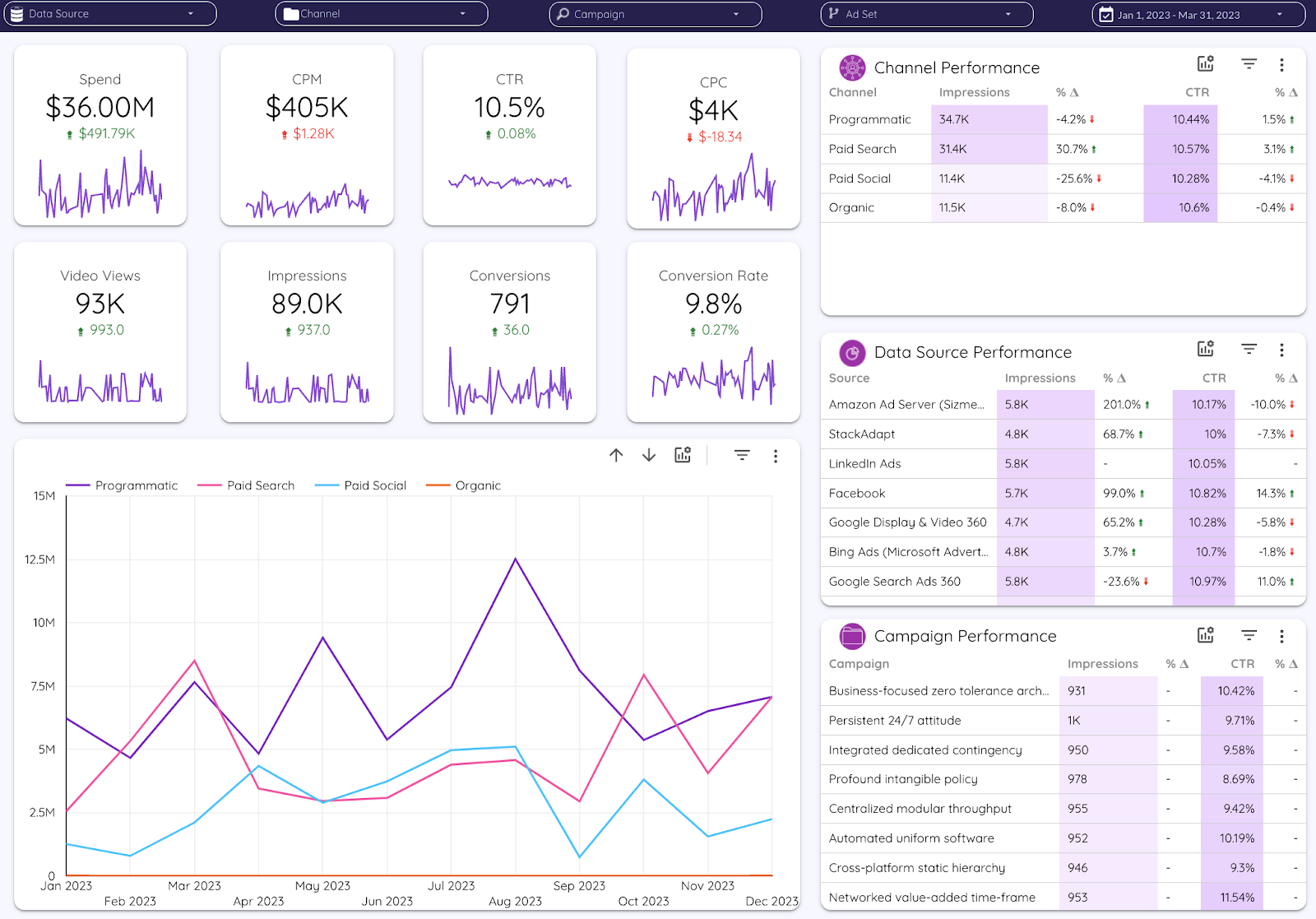
Improvado is a marketing analytics platform that streamlines cross-channel analytics by automating data aggregation, transformation, and visualization
Key features:
- Cross-channel data integration: Connects with 500+ data sources, including ad platforms, CRM systems, and web analytics tools, ensuring a unified marketing data environment.
- Automated data transformation: Standardizes naming conventions, aligns disparate metrics, maps, blends, and joins data for accurate cross-channel comparisons.
- Custom marketing attribution modeling: Supports common single-, multi-touch and custom attribution models, allowing marketers to analyze how different channels contribute to conversions.
- Data storage: Improvado supports multiple data storage options and provides data warehouse management as a service, ensuring historical and real-time data remain accessible, structured, and ready for in-depth analysis.
- Automated data compliance monitoring and metric pacing: Improvado offers a solution for campaign, brand, and data compliance. Marketers can set custom rules or choose from a library of 250+ pre-built rules your campaign should follow. It monitors compliance in real time and alerts of any issues and metrics drops.
#2 Hubspot
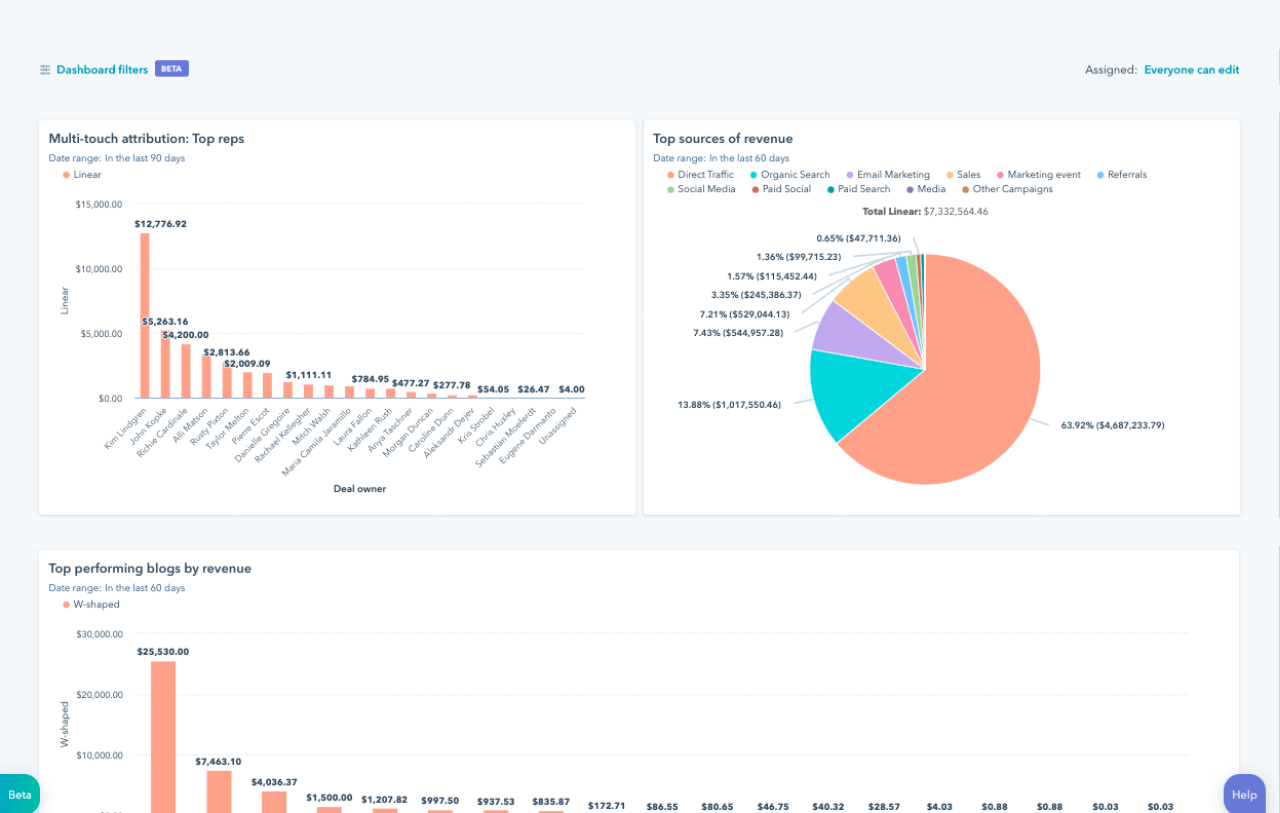
HubSpot is an all-in-one marketing, sales, and CRM platform that provides built-in cross-channel analytics to help marketers track performance across email, social media, paid ads, and website interactions.
Key features:
- Multi-channel performance tracking: HubSpot unifies data from email campaigns, social media, paid ads, SEO, and website activity, allowing marketing teams to measure engagement and conversions across different touchpoints.
- Attribution reporting: The platform includes built-in attribution models to analyze the impact of different channels on customer acquisition, helping teams allocate budget more effectively.
- Automated data Integration: Seamlessly connects with major ad platforms like Google Ads, Facebook Ads, and LinkedIn Ads, eliminating manual data uploads and reducing discrepancies in reporting.
- Custom dashboards and reports: Users can build customizable reports to compare channel performance, segment audiences, and track KPIs in real time.
- CRM-integrated analytics: Hubspot links marketing efforts to sales and customer lifecycle stages, providing insights into how different channels influence pipeline growth and revenue.
#3 Google Analytics 4
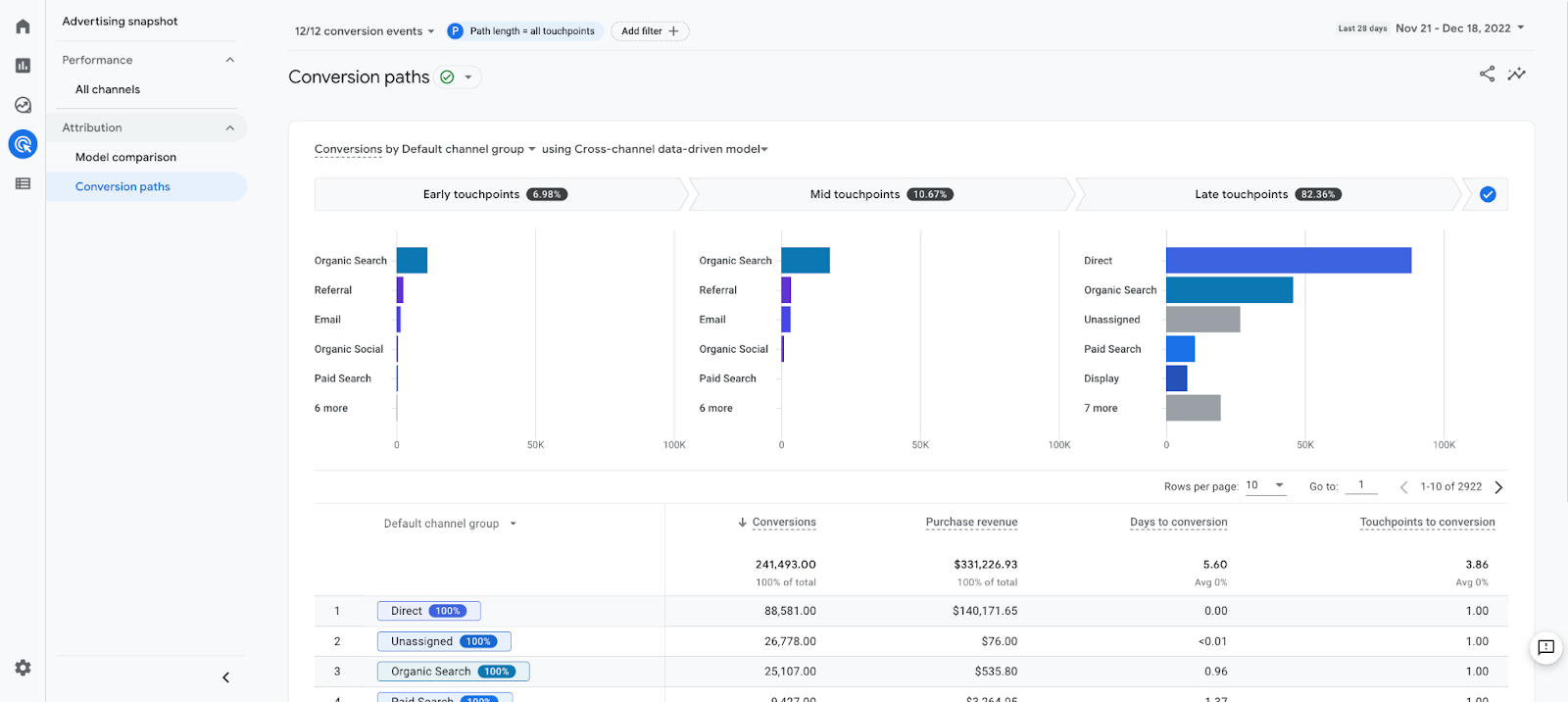
Google Analytics 4 (GA4) is a powerful tool for tracking user behavior across multiple touchpoints.
Key features:
- Event-based tracking: GA4 logs user interactions—like clicks, form submissions, and purchases—as standalone events, allowing granular measurement of user actions across devices and platforms without reliance on cookies.
- Conversion attribution: Offers multi-touch attribution models, including data-driven attribution, which dynamically assigns conversion credit based on machine learning rather than predefined rules. However, GA4’s attribution is limited to Google’s ecosystem, making it difficult to connect external ad platforms.
- Cross-platform tracking: Uses Google Signals, User-ID, and first-party data stitching to unify user interactions across web and app environments, but accuracy depends on logged-in users and consented data.
- Predictive metrics: Leverages machine learning to forecast churn probability, purchase likelihood, and revenue potential, allowing marketers to refine audience targeting and budget allocation.
- Custom reporting and exploration: Provides tools like Funnel Analysis, Path Exploration, and Segment Overlap to break down cross-channel user behavior, but lacks native integrations with external BI tools, requiring BigQuery for advanced queries.
#4 Semrush
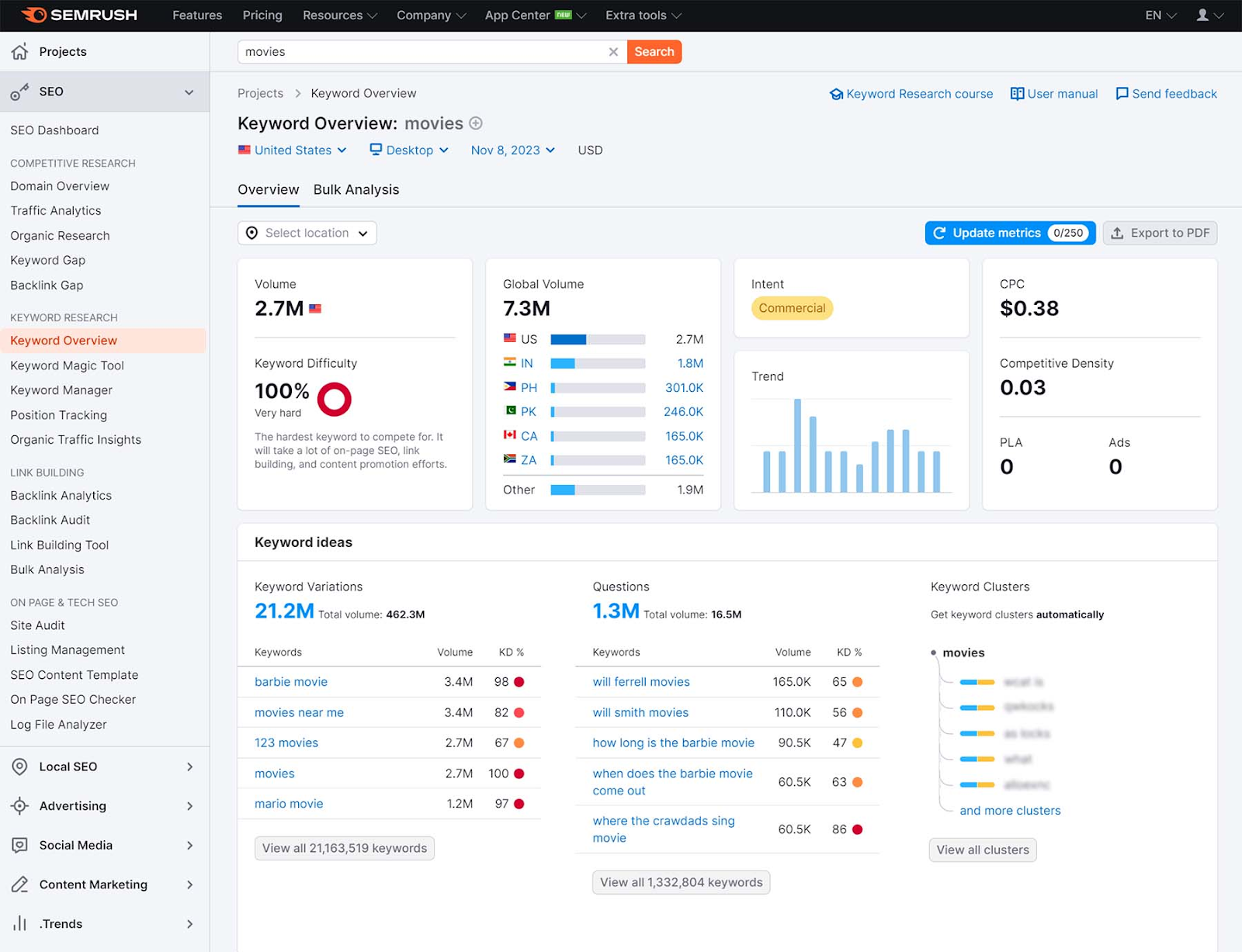
Semrush is a comprehensive digital marketing platform that provides deep insights into SEO, paid advertising, content marketing, and competitor analysis.
Key features:
- Cross-channel traffic analytics: Semrush provides visibility into how different channels (organic, paid, social, and referral) contribute to overall traffic and user engagement.
- Advertising research and competitive benchmarking: Analyzes paid search and display ad strategies across platforms like Google Ads and Microsoft Ads, helping marketers identify gaps and refine bidding strategies.
- Social media and content performance tracking: Monitors engagement, audience growth, and content effectiveness across social platforms, helping align messaging with audience behavior.
- Market and audience intelligence: Aggregates demographic, psychographic, and behavioral data to refine audience targeting and improve cross-channel marketing personalization.
#5 Tableau
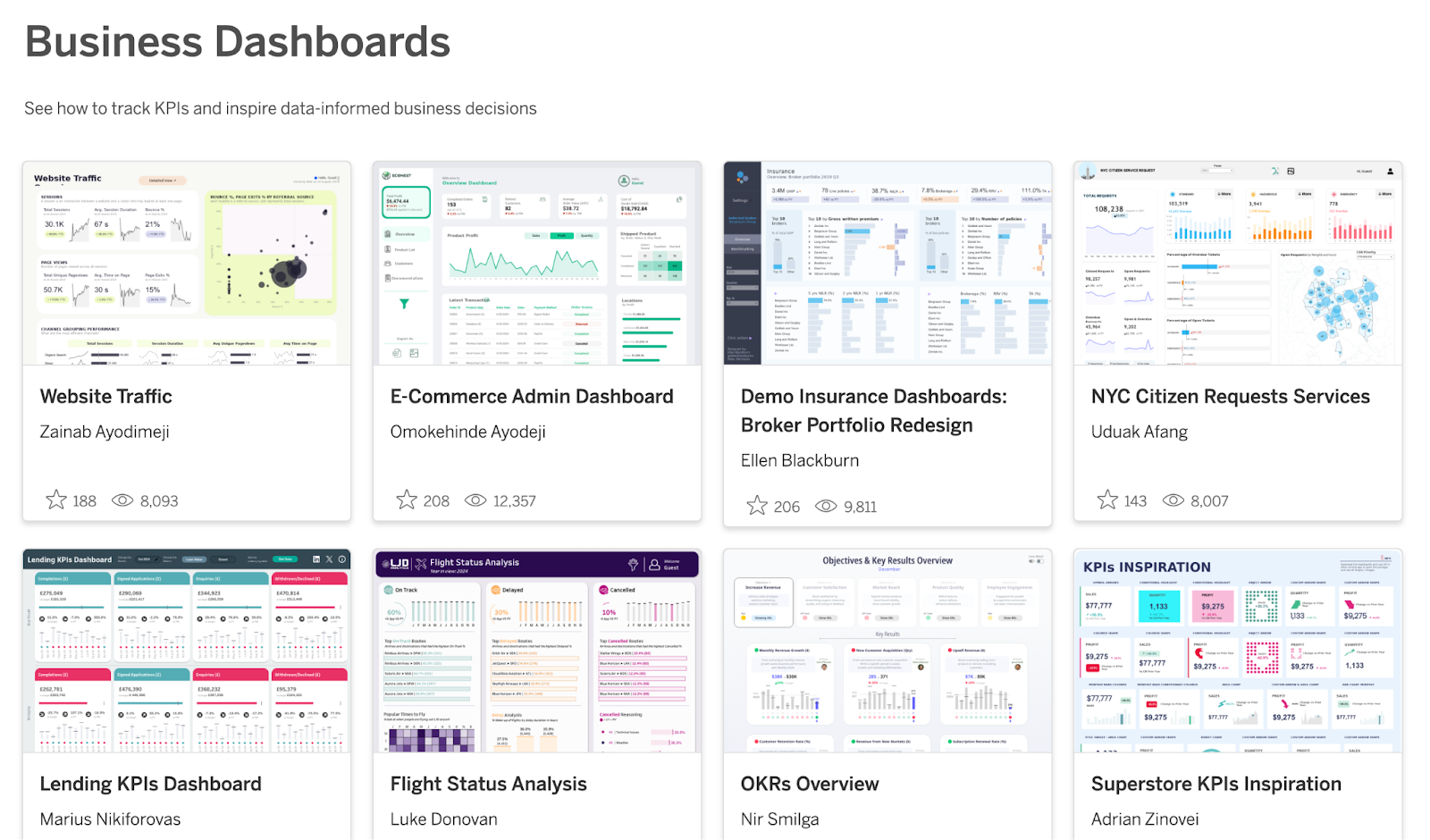
Tableau is not a marketing analytics platform itself, but it plays a crucial role in cross-channel analysis by visualizing complex marketing data.
Key features:
- Customizable dashboards and reports: Enables analysts to build dynamic dashboards that track KPIs, customer journeys, and attribution models across multiple touchpoints.
- Predictive analytics and AI-driven insights: Tableau uses machine learning models to detect patterns in customer behavior, forecast campaign performance, and recommend budget allocation strategies.
- Integration with ETL and data warehousing solutions: Tableau seamlessly integrates with ETL tools like Improvado to automate data extraction, transformation, and loading, ensuring accurate and real-time reporting.
Get more out of your cross-channel marketing data
Cross-channel marketing analytics unlocks a clearer understanding of customer behavior, improves campaign efficiency, and ensures every marketing dollar is spent where it drives the most impact. Without a unified view, key insights get lost in platform silos.
Building a strong data foundation is the first step toward effective cross-channel strategies. Improvado streamlines data integration, transformation, and reporting, helping marketing teams connect the dots across every channel. Get a demo to see how Improvado can power your analytics and maximize your marketing performance.
.png)
.jpeg)
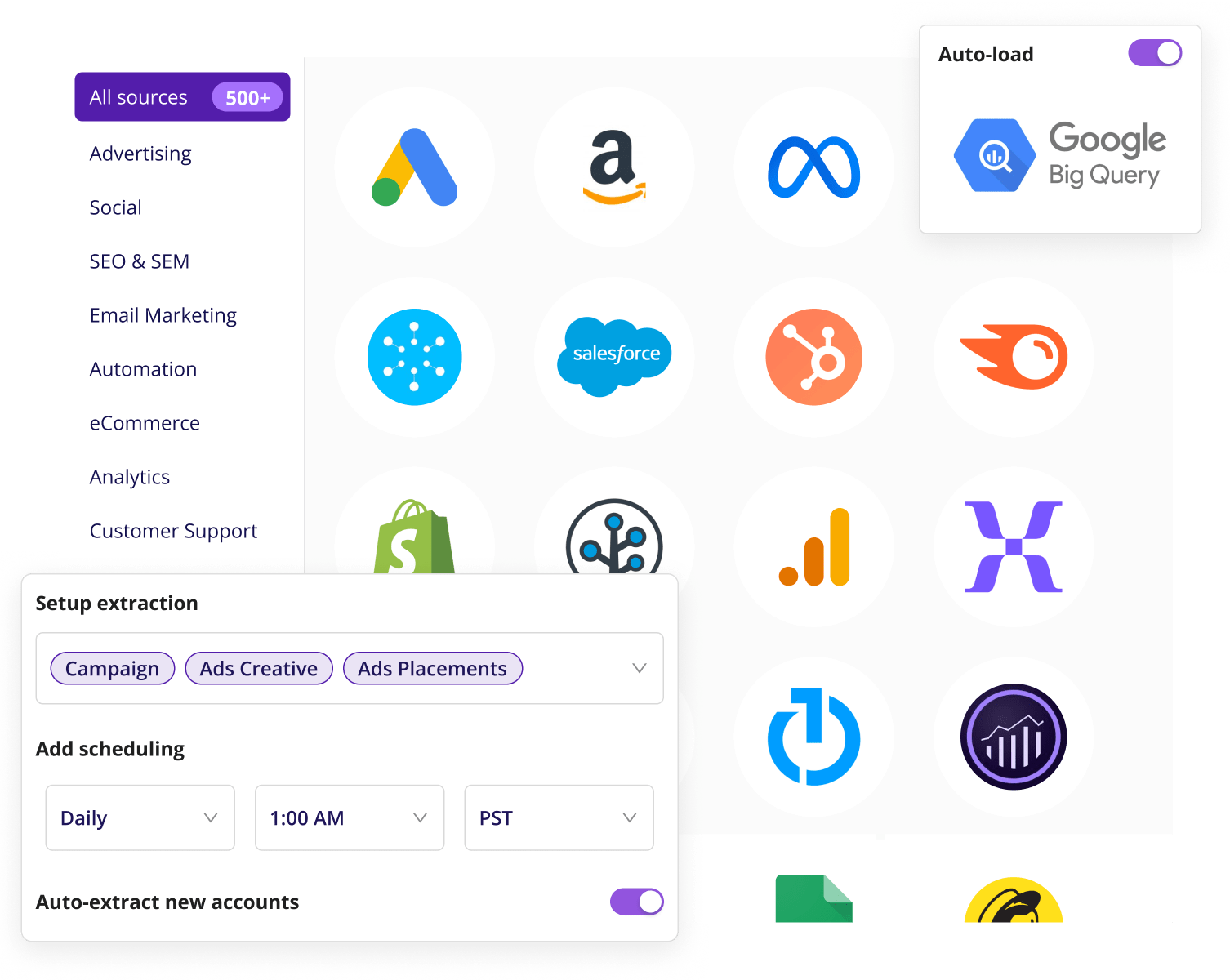
%20(1).png)


.png)
